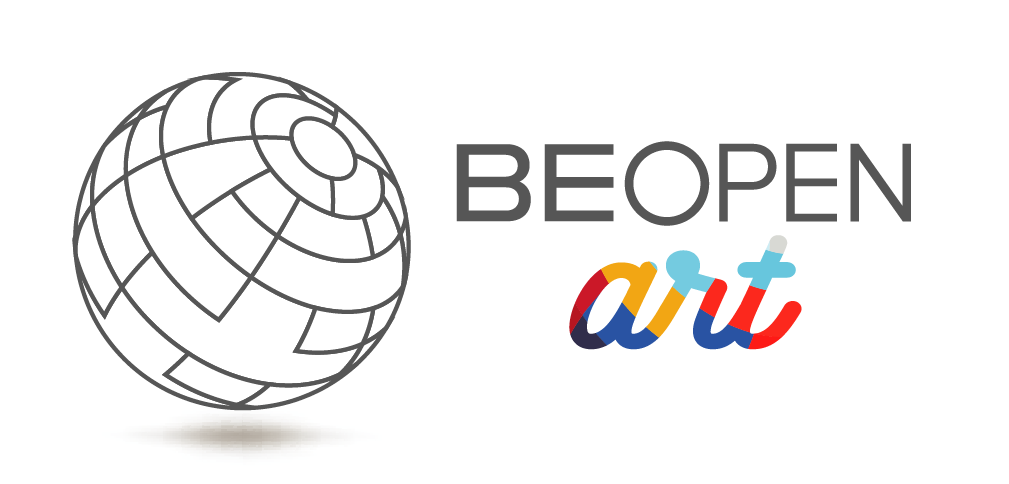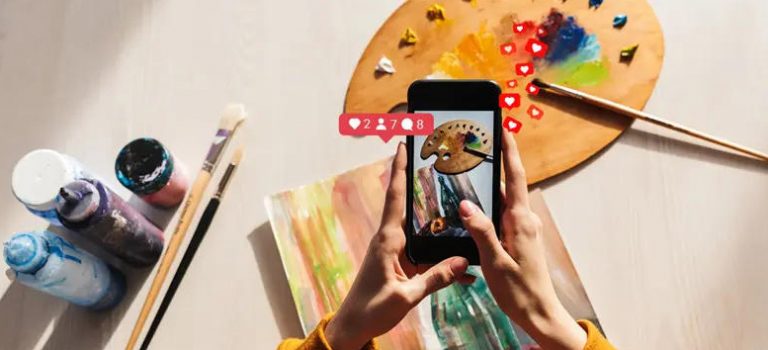Source: Social Pilot.
Here are the 10 best social media platforms for artists. Learn about the best strategies, tips & tools to grow on social media platforms as an artist and connect with a relevant global audience.
With almost 60% of the global population actively using social media, it’s no surprise that it has become a highly rewarding marketing channel for artists. It provides a space to share your art with the world, draw inspiration from others, and reach potential buyers.
However, is it enough to focus solely on promoting your art for social marketing?
Or, what content strategies should you adopt to promote your art on social media?
This blog will address all these questions and offer the ideal strategies for artists to promote their art on social media.
But first, let’s explore some of the significant benefits social media offers artists.
- Broad Reach: Social media allows you to promote your art to a larger audience with just a few clicks.
- Cost-Effective Online Presence: Social marketing enables artists to establish a strong online presence without incurring high costs.
- Unlimited Inspiration: Social media serves as a platform to discover limitless inspirations from fellow artists worldwide.
- Community Building: It allows you to connect and collaborate with like-minded peers, fostering a supportive artistic community.
- Audience Engagement: Social marketing channels are a convenient way of cultivating a loyal audience base that engages with your content.
- Direct Sales: Social media can facilitate the direct sale of your art to interested buyers, expanding your reach and potential sales.
Having understood the benefits of social marketing, let’s look at all the relevant social channels you can consider for art marketing.
Social media is powerful and has revolutionized how artists connect with audiences and prospective buyers. With over four billion social media users, artists gain unparalleled opportunities on social media to showcase their art and engage with art enthusiasts. With that in mind, here are the best social media platforms for artists:
1. Instagram for Artists
According to Statista, 74% of art buyers use Instagram to purchase art from social media, making it a preferred platform for connecting with potential buyers and followers. Instagram’s visual-centric layout is ideal for showcasing artwork.
With Instagram’s image and video-sharing features, artists can display their portfolios, behind-the-scenes process, and completed pieces to a wide audience. Its extensive use of hashtags and Explore Page also provides an opportunity to reach art enthusiasts and potential buyers.Instagram’s storytelling capabilities through Stories and IGTV offer a unique way to engage followers with your creative journey.
To learn more about Instagram marketing, consider reading this blog on tips and strategies to ace Instagram marketing.
2. Facebook for Artists
Facebook provides a platform for artists to interact with the audience through Stories, Reels, and feed posts.
Unlike Instagram, Facebook allows you to create a professional artist page to showcase your achievements. Facebook’s Business pages enable artists to create an online presence, promote artwork, and even sell pieces directly through the platform’s marketplace feature.
Additionally, Facebook offers artists the advantage of connecting with specific art communities through groups. By joining and participating in art-related groups, artists can build their network, share their work, receive feedback, and collaborate with fellow artists.
3. DeviantArt for Artists
DeviantArt is an online community specifically tailored for artists. It allows artists to showcase their art and expand their social network. Artists can use DeviantArt to create a personalized gallery that exhibits their artwork, ranging from digital illustrations to traditional paintings and sculptures.
This platform provides room to explore various artistic genres and styles for inspiration and feedback. Its community features, such as groups, forums, and critiques, foster a supportive artistic growth and collaboration environment. You can engage with the community by commenting on other artists’ work and participating in group discussions and contests.
DeviantArt offers opportunities to gain recognition through daily deviations and features, showcasing talent to a vast community of art enthusiasts. Also, artists can sell artwork and prints through the platform’s integrated marketplace.
4. Behance for Artists
Behance, an Adobe-owned platform with over 40 million users worldwide, is ideal for creating a professional portfolio for artists and creatives. Artists can use Behance to create an impressive portfolio highlighting their best artwork that emphasizes their unique style and skills.
The platform allows artists to engage with other artists by appreciating and commenting on their work, building connections, and fostering collaborations. Artists can also participate in Behance’s curated galleries and themed collections to increase their visibility among potential clients, art directors, and industry professionals.
Behance’s job board provides a platform to explore career opportunities and freelance projects in the creative industry.
5. Pinterest for Artists
With over 400 million monthly active users, Pinterest offers the opportunity to drive traffic to your website and attract sales. It is a visual discovery platform for artists to curate inspiring boards and reach a diverse audience. The platform allows artists to create pinboards to reflect their artistic interests and showcase their work alongside other captivating images.
A great way to tap into the platform’s algorithm is to optimize your Pinterest profile by using relevant keywords and hashtags to ensure your artwork appears in searches and recommendations.
Artists can leverage Pinterest to engage audiences interested in art and potentially lead traffic to their website or other online platforms. Artists can also engage with the community by following other artists, repinning their work, and joining group boards focused on art and creativity.
6. YouTube for Artists
Artists on YouTube generate billions of views each year, providing an excellent opportunity for exposure, establishing expertise, and attracting potential buyers. YouTube is a powerful platform for artists to share their artistic process and art tutorials through videos.
Additionally, artists can leverage YouTube Shorts and create captivating short-form videos to showcase their artwork, discuss inspirations, and offer tips to other aspiring artists.
To make the most of this platform, consider pushing for engagement through comments and subscriptions, fostering a community of art enthusiasts who appreciate your content.
7. TikTok for Artists
Due to its short-form engaging content, TikTok is increasingly becoming a platform of interest for artists. Artists can use TikTok’s video format to showcase their creativity through quick art demos, time-lapse drawings, or visual storytelling. They can leverage TikTok’s trends, challenges, and music features to create visually captivating and shareable content.
Artists can also experiment with trending challenges and popular sounds to enhance their visibility and reach a wider audience. This platform is excellent for engaging with other creators, participating in art-related conversations, and collaborating with fellow artists to expand your network.
8. Tumblr for Artists
Tumblr is a standout platform in the artistic cosmos, with many artists choosing it as their creative haven.
The platform hosts a diverse community of artists and art lovers worldwide, providing a space for artists to engage in conversations, discover new artistic styles, and draw inspiration from a vast array of talents.
Tumblr’s unique reblogging feature allows artists’ work to reach an extensive network of users through the power of sharing. When an artist’s work resonates with someone, they can reblog it, exposing their creativity to their followers and potentially sparking a ripple effect of visibility and recognition.
9. ArtStation for Artists
ArtStation serves as a premier platform for artists in the entertainment industry, with a focus on concept art, character design, and digital illustration. It is an excellent platform for artists to create a professional portfolio showcasing their best artwork and emphasizing their skills and expertise.
The ArtStation community provides a space for artists to engage by appreciating and commenting on other artists’ work. The platform serves as a great resource for establishing connections with industry professionals and receiving feedback to refine your craft further.
ArtStation’s specialized focus on high-quality artwork and its community of talented artists make it a valuable platform for professionals seeking to elevate their careers. Artists can also explore job postings, freelance opportunities, and art challenges on ArtStation to expand their career prospects and gain recognition in the industry.
How to Select the Right Platform?
Choosing the right platform begins with identifying your target audience. Ask yourself:
- Who are the people that would appreciate your art?
- Are you creating contemporary pieces that resonate with a younger crowd?
- Do your masterpieces appeal to a more mature and sophisticated art-loving community?
Understanding your audience will help narrow down the social media platforms where they hang out. Once you identify them, consider the visual nature of your art.
Platforms that offer a better visual aesthetic should be your preference for showcasing your artwork. For instance, Instagram is known for offering stunning visuals and artistic communities, making it excellent for sharing your portfolio and engaging with fellow artists and art enthusiasts. Even platforms like Pinterest, which are highly visual, can work in your favor and amplify your art to a broader audience.
Keep in mind that finding the right social media platform for promoting your art is all about understanding your audience, showcasing your visuals effectively, and engaging with art communities.
Here are some key points about all major social media platforms that you can consider.

The rapid evolution of social media from a networking hub to a significant marketing platform underscores the importance of strategic marketing.
Here are five social media marketing strategies tailored specifically for artists:
1. Take Advantage of Email Marketing
Email marketing offers a direct line of communication to your audience. Research indicates that approximately 50% of email subscribers make purchases from marketing emails, highlighting the potential of email marketing for artists. Revenue generated through email marketing is projected to reach $17.9 billion by 2027.
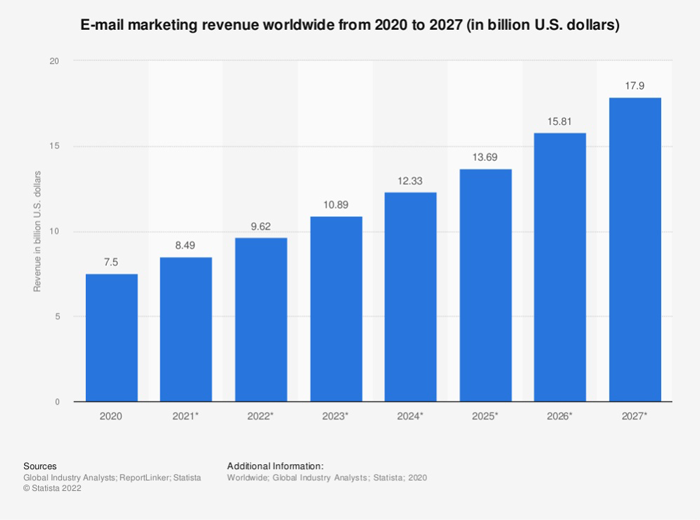
However, building an email list requires strategic actions to encourage people to sign up. So, start by choosing an email service like MailChimp or AWeber. After that, create compelling calls to action in your content that lead people to sign up for your email list.
Once your email list is ready, decide on the type of content you want to send out to your audience. This could be a mix of exclusive content, behind-the-scenes insights, and special promotions to incentivize sign-ups. Email marketing can also help artists to expand their customer lifetime value.
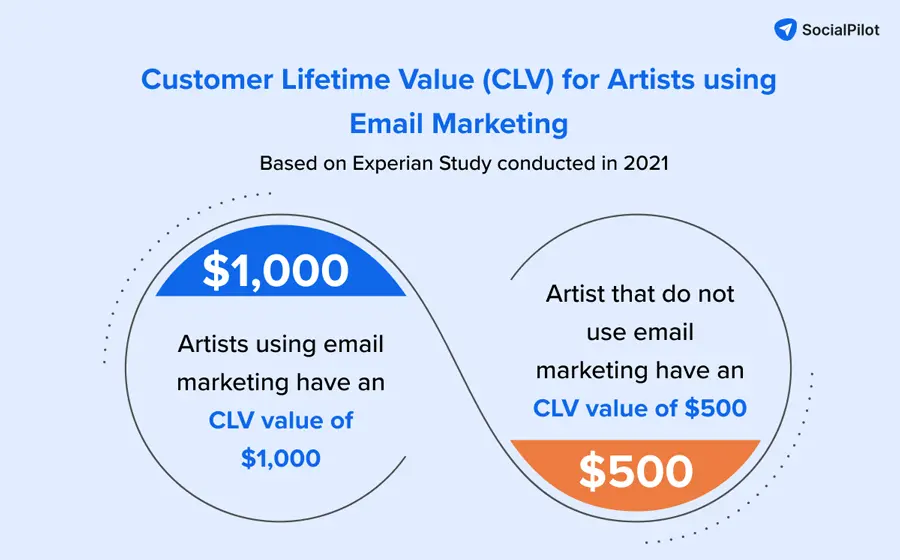
Use email marketing wisely and create campaigns to share your latest artwork, exhibition announcements, and updates on your creative journey. Remember, engaging and valuable content is key to successful email marketing campaigns. If your emails aren’t interesting, your open rate will significantly drop over time.
2. Build and Nurture an Online Community
Social media provides an opportunity to build and nurture an online community in a virtual environment. However, with multiple brands across various domains attempting to build their community, you need to be strategic with your approach.
But, how difficult is it to build a community?
Building an online community as an artist is not a one-day job but a continuous process requiring constant effort. To foster a sense of community, you can start by engaging with your audience and fellow artists. In addition to posting engaging content, respond to your audience through comments, encourage discussions, and host giveaways and contests.
Growing your audience across social media helps you gain recognition and build your community. However, you must first identify your audience demographics to know who you want to contact to grow it.
Once you clearly understand your target audience, the next step is to create content that truly resonates with them. This is where a well-crafted content marketing plan comes into play. Aim to develop a plan that aligns with SMART (Specific, Measurable, Achievable, Relevant, Time-bound) marketing goals.
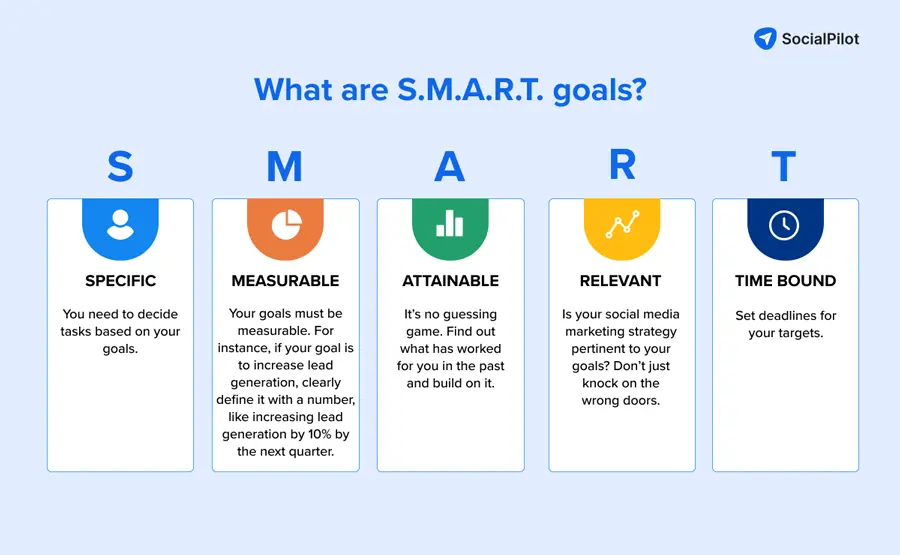
With a SMART marketing goal in place, you can then shift your focus towards creating a marketing strategy. A strategy that specifically aims to grow your audience.
But here’s the thing:
Each social media platform will require different marketing efforts to achieve your marketing goal. For instance, when creating content for Facebook, you need to make it more sharable to improve its reach. You can also create Reels that have the potential to go viral on Facebook.
Now, if we shift our focus to Instagram, you can leverage relevant hashtag clusters to reach a larger audience organically. Although, it’s important to note that the organic reach on all social media platforms has significantly dropped over the last decade. In 2022 alone, the organic reach rate for Instagram and Facebook dropped by 9.34% and 4.32%, respectively.
This decreased organic reach emphasizes the importance of paid advertising to grow your audience and convert them into customers. To run effective paid marketing campaigns, identify the content that has been performing well organically and use it to fuel your paid campaigns.
Another crucial factor in growing your audience is consistently engaging your followers. Respond to comments and reviews to show appreciation for their support. You can also run contests and giveaways to spark excitement and attract new followers.
By implementing these strategies, you can connect with art lovers, collectors, and fellow artists, expanding your audience and showcasing your unique talent.
4. Determine the Best Time to Post
Identifying the best time to post to attract a higher engagement is crucial. No universally ideal time for posting on social media guarantees engagement because every platform differs. Still, here is a general guideline for the best time to post on social media overall.
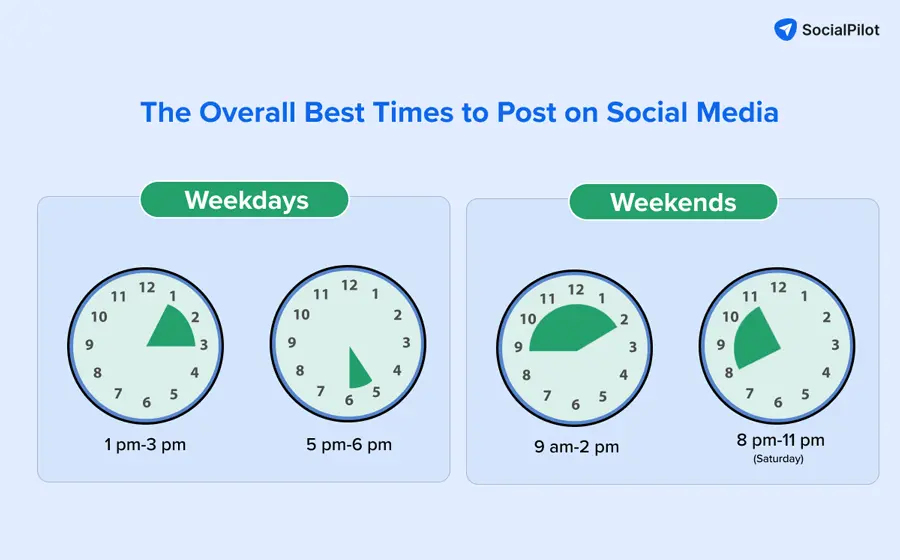
To find the best time slot for you, experiment with different posting times and use social media analytics tools to determine when your audience is most active.
To know more, go ahead and read our ultimate guide on the best time to post on social media.
5. Collaborate With Other Artists
Collaborations with other artists can be mutually beneficial, exposing your artwork to new audiences. Artist collaboration with other artists and influencers can be a way of attracting new audiences and potential buyers. Collaborating with other artists allows you to push ideas and come up with something extraordinary.
If you’re considering a collaboration, either choose to go for a one-time collaboration or a long-term alliance that benefits both contributors. You can also have multiple one-time collaborations with various influencers.
Embarking on a collaboration strategy requires careful planning and consideration. Here are some key steps to keep in mind:
- Research for collaborators and make a list of relevant influencers with whom you can collaborate.
- Reach out to relevant influencers and agree on a collaboration goal.
- Brainstorm content ideas that can make for a perfect collaboration post.
- Decide what, when, and where to post your collaborated content.
- Lastly, cross-promote your content to win maximum reach and engagement.
Here is an example of a successful artist collaboration by Banksy X The Walled Off Hotel.
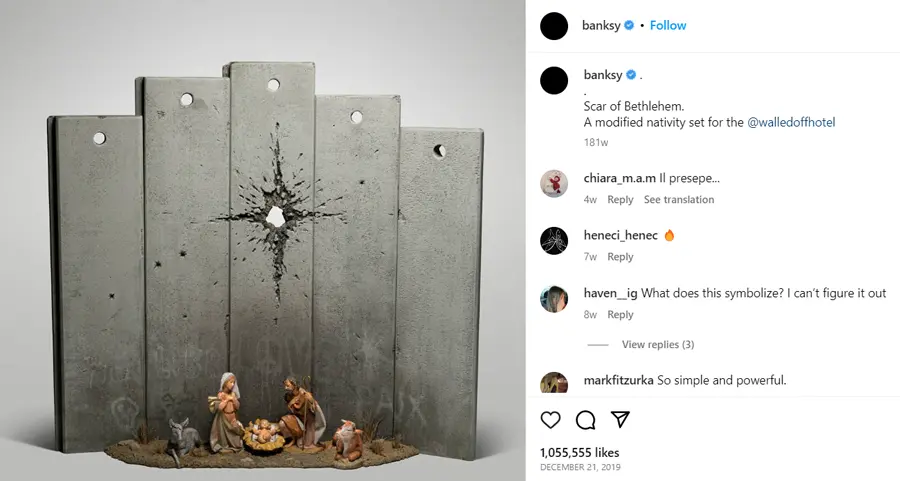
Banksy shared his powerful art with a simple social media post, sparking excitement among art lovers. This collaboration invited people to visit The Walled Off Hotel to view this art piece in person once it was placed.
In essence, collaborations can serve as a form of advocacy, introducing you to the followers of your fellow contributors.
Social media has changed how art marketing works and how people buy it. But not all artists succeed with social selling. Here are three reasons artists fail on social media with their solutions:
1. Undefined Brand Identity
Problem: Many artists struggle to define a unique brand identity that sets them apart from the competition. A brand identity visually represents an artist’s values, style, and story. Without clear brand identity, artists can blend into the background in the crowded social media landscape, making it difficult for potential followers or customers to find and connect with them.
Solution: Artists should invest time in identifying their unique style, color schemes, values, and storytelling elements. Incorporating these elements into their social media presence can create a cohesive and recognizable brand identity. This could involve using consistent color schemes in their posts, sharing stories about their creative process, or highlighting the values that drive their work.
2. Inconsistent Posting
Problem: Some artists fail to maintain a consistent posting schedule on their social media platforms. Consistency is key to social media success. Regularly posting high-quality content keeps an artist’s work in the minds of their followers and increases the chances of their posts being seen and engaged with. However, inconsistency can lead to a decrease in engagement and a loss of interest from their audience.
Solution: Artists should develop a content strategy emphasizing regular posting of quality content. Establishing a posting schedule that aligns with their capacity and the behavior of their audience can help. Utilizing scheduling tools can assist in planning content in advance and maintaining a consistent online presence.
3. Lack of a Dedicated Plan
Problem: Many artists approach social media without a dedicated plan, leading to haphazard posting and missed opportunities for engagement and growth. Without a clear plan, artists may post content that doesn’t resonate with their audience or fail to take advantage of optimal posting times.
Solution: Artists should set up SMART (Specific, Measurable, Achievable, Relevant, Time-bound) marketing goals and plan their content strategy accordingly. This strategy should offer a mix of promotional, educational, and entertaining content. By doing so, artists can improve audience engagement, build genuine connections with their audience, foster loyalty, and strengthen their online presence.
With multiple competitors trying to get the audience’s attention on social media, it becomes important to stand out and stand your unique presence.
To help you do that, here are the best tools to support your social media marketing initiatives:
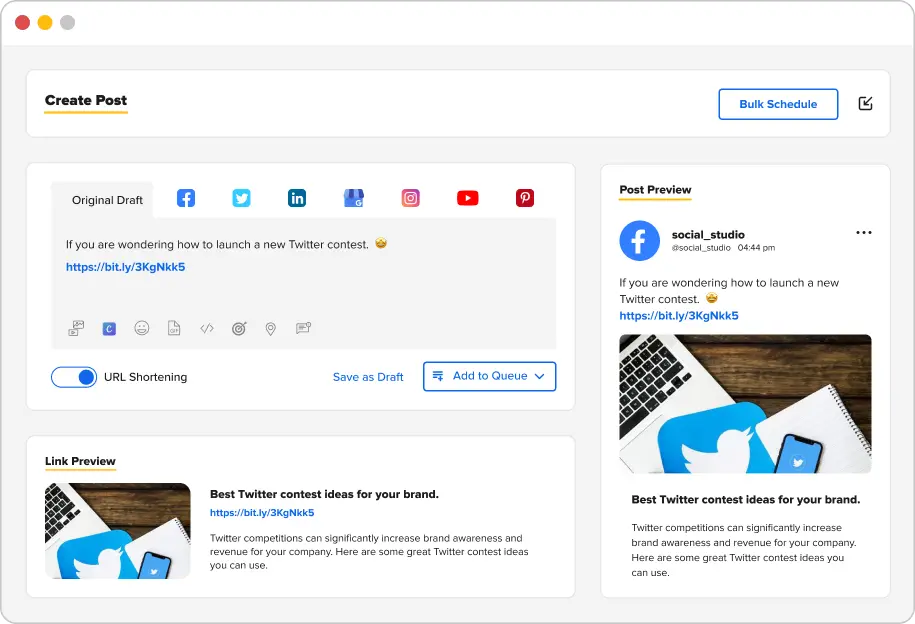
SocialPilot is one of the best social media management tools you can use for social media marketing. Here are some of its rewarding features to up your social media game:
Content Library: SocialPilot offers a robust content library that backs you up with visual assets you can find and use anytime. With this Content Library, you can easily organize your content and save time finding hashtag clusters and images while creating a content draft.
Scheduling and Publishing: Gone are the days when you had to spend time posting content manually. With SocialPilot’s Scheduling and Publishing capabilities, you can plan your content and set up a consistent posting schedule.
Analytics: For deriving success from your social marketing efforts, it is important to understand the performance of your content. SocialPilot offers detailed content performance analytics reports that provide valuable insights into your content’s performance. This feature helps you to dive deep into engagement metrics and track reach and impressions to gain a clear understanding of your audience demographics as well.
Social Inbox: Engagement is key to building a strong social media presence, and SocialPilot’s Social Inbox feature helps you do just that. With this feature, you can stay on top of all your social media conversations by monitoring and responding promptly to comments, messages, and mentions, ultimately helping you nurture meaningful connections with your audience.
Collaboration: The Collaboration feature allows you to collaborate with your team members or clients seamlessly. You can assign tasks, review content, and provide feedback within SocialPilot’s dashboard to streamline your workflow and enhance productivity.
2. Canva: Design Stunning Visuals with Ease
A user-friendly design tool, Canva allows artists to create stunning visuals for social media. It offers a vast library of design elements and easy-to-follow tutorials for beginners.
3. Saatchi Art: Showcase and Sell Your Artwork
This platform is an online marketplace for artists to showcase and sell their work. Artists can share product links on social media, driving direct leads and expanding their reach.
4. Snapseed: Enhance and Edit Your Photos on the Go
This mobile photo editing app provides a range of features to enhance your images. It’s perfect for on-the-go adjustments and artistic effects.
5. Animoto: Create Stunning Videos in Minutes
Animoto simplifies video creation with its drag-and-drop interface. It allows artists to create professional videos, add music, transitions, and text overlays.
6. GIMP: Unleash Your Image Editing Skills
GIMP is a versatile image editing tool for adjusting color tones, creating digital artwork, and removing imperfections. It’s perfect for creating appealing visuals for social profiles.
7. Lightworks: Craft Professional Videos with Ease
Lightworks is a free video editing tool that helps artists create professional-grade videos. It offers precise editing controls and supports various video formats.
8. ChatGPT: Engage and Interact with AI
This AI chatbot generates engaging content and can answer customer FAQs. It helps maintain a human touch in your brand voice and saves time on content-based tasks.
9. Feedly: Stay Updated and Curate Engaging Content
Feedly is a news aggregator tool that compiles feeds from multiple online sources. It helps artists stay updated on trends and curate engaging content for their social media profiles.
10. Splice: Edit Professional Videos on Your Mobile Device
Splice is a mobile-friendly video editing tool for creating polished videos directly from your smartphone. It offers a user-friendly interface for effortless video editing.
Conclusion
Social media has become a must-use marketing channel for artists across all streams. Every platform can uniquely showcase your talent, attract new followers and monetize your art.
So, start by identifying the benefits of each platform before choosing the best rewarding ones for your art. After doing that, implement the right strategies and make your content stand out from the competition.
Of course, doing all this on your own isn’t easy.
This is why SocialPilot is what you need! The platform can help you build a strong social media presence with its wide range of features. With a few clicks, you can schedule your content calendar, engage with your audience and monitor performance from a unified dashboard.
